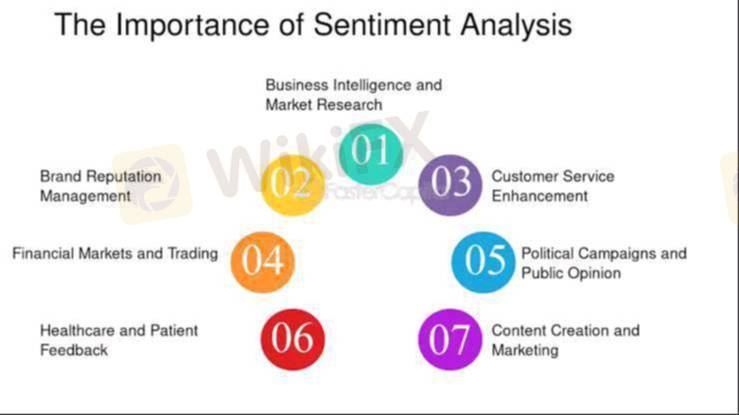
2025-02-17 22:01
In der IndustrieThe role of sentiment analysis in risk mitigation.
#forexrisktip
Sentiment analysis plays a crucial role in risk mitigation by allowing organizations to understand and respond to public sentiment about their brand, products, or services. Here's how it works:
1. Identifying Potential Risks:
* Early Warning System: By monitoring social media, news articles, and other online platforms, sentiment analysis tools can detect emerging negative trends or opinions that could escalate into a crisis.
* Cybersecurity Threats: Sentiment analysis can be used to identify potential cyber threats by analyzing emotional tones in online discussions, social media, and communications. This can help organizations detect and prevent cyberattacks.
* Brand Reputation: Sentiment analysis can help organizations understand how their brand is perceived by the public. This information can be used to mitigate risks to brand reputation.
2. Proactive Mitigation:
* Address Issues Promptly: Once a potential risk is identified, organizations can take proactive steps to address the issue before it escalates. This might involve responding to negative feedback, issuing a public statement, or taking corrective action.
* Improve Customer Experience: By understanding customer sentiment, organizations can identify areas where they can improve the customer experience and reduce the risk of negative feedback.
3. Crisis Management:
* Monitor Public Reaction: During a crisis, sentiment analysis can be used to monitor public reaction and understand how the situation is being perceived. This information can be used to inform crisis communication strategies.
* Measure the Effectiveness of Responses: Sentiment analysis can be used to measure the effectiveness of crisis response strategies and make adjustments as needed.
Examples of Sentiment Analysis in Risk Mitigation:
* A company detects a spike in negative sentiment on social media about a new product. They investigate the issue and find that customers are unhappy with a specific feature. The company can then take steps to address the issue, such as releasing a software update or offering refunds.
* A financial institution uses sentiment analysis to monitor news articles and social media for mentions of potential risks to the financial system. This information can be used to inform risk management strategies.
* A government agency uses sentiment analysis to monitor public opinion about a new policy. This information can be used to identify potential areas of concern and make adjustments to the policy.
By using sentiment analysis effectively, organizations can identify and mitigate risks before they cause significant damage to their brand, reputation, or bottom line.
Gefällt 0
FX2409028569
Händler
Aktueller Inhalt
In der Industrie
Event-A comment a day,Keep rewards worthy up to$27
In der Industrie
Nigeria Event Giveaway-Win₦5000 Mobilephone Credit
In der Industrie
Nigeria Event Giveaway-Win ₦2500 MobilePhoneCredit
In der Industrie
South Africa Event-Come&Win 240ZAR Phone Credit
In der Industrie
Nigeria Event-Discuss Forex&Win2500NGN PhoneCredit
In der Industrie
[Nigeria Event]Discuss&win 2500 Naira Phone Credit
Kategorie

Plattform

Ausstellung

IB

Rekrutierung

EA

In der Industrie

Markt

Index
The role of sentiment analysis in risk mitigation.
 Indien | 2025-02-17 22:01
Indien | 2025-02-17 22:01#forexrisktip
Sentiment analysis plays a crucial role in risk mitigation by allowing organizations to understand and respond to public sentiment about their brand, products, or services. Here's how it works:
1. Identifying Potential Risks:
* Early Warning System: By monitoring social media, news articles, and other online platforms, sentiment analysis tools can detect emerging negative trends or opinions that could escalate into a crisis.
* Cybersecurity Threats: Sentiment analysis can be used to identify potential cyber threats by analyzing emotional tones in online discussions, social media, and communications. This can help organizations detect and prevent cyberattacks.
* Brand Reputation: Sentiment analysis can help organizations understand how their brand is perceived by the public. This information can be used to mitigate risks to brand reputation.
2. Proactive Mitigation:
* Address Issues Promptly: Once a potential risk is identified, organizations can take proactive steps to address the issue before it escalates. This might involve responding to negative feedback, issuing a public statement, or taking corrective action.
* Improve Customer Experience: By understanding customer sentiment, organizations can identify areas where they can improve the customer experience and reduce the risk of negative feedback.
3. Crisis Management:
* Monitor Public Reaction: During a crisis, sentiment analysis can be used to monitor public reaction and understand how the situation is being perceived. This information can be used to inform crisis communication strategies.
* Measure the Effectiveness of Responses: Sentiment analysis can be used to measure the effectiveness of crisis response strategies and make adjustments as needed.
Examples of Sentiment Analysis in Risk Mitigation:
* A company detects a spike in negative sentiment on social media about a new product. They investigate the issue and find that customers are unhappy with a specific feature. The company can then take steps to address the issue, such as releasing a software update or offering refunds.
* A financial institution uses sentiment analysis to monitor news articles and social media for mentions of potential risks to the financial system. This information can be used to inform risk management strategies.
* A government agency uses sentiment analysis to monitor public opinion about a new policy. This information can be used to identify potential areas of concern and make adjustments to the policy.
By using sentiment analysis effectively, organizations can identify and mitigate risks before they cause significant damage to their brand, reputation, or bottom line.
Gefällt 0
Ich möchte auch kommentieren
Einreichen
0Kommentare

Es gibt noch keinen Kommentar. Mach den ersten

Einreichen
Es gibt noch keinen Kommentar. Mach den ersten